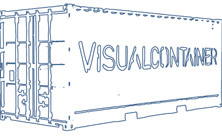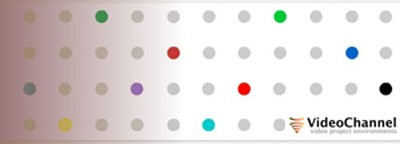Latest news
Iscriviti alla Newsletter
Set
23
Archeology Museum – Inner Yard
Varna, Bulgaria
4 – 13 Agosto 2009
Visualcontainer è stata invitata a partecipare con una selezione di artisti italiani al Videoholica Festival a Varna.
Durante i giorni del festival lo staff di visualcontainer è stato invitato a tenere una conferenza sui seguenti temi:
Il mondo della videoarte e il ruolo dei distributor e le ultime tecnologie di comunicazione, in particolare il caso di VisualcontainerTV
Conferenza:
11 August 2009 – 21.00
Archeology museum/ Inner yard
Presentazione di Visualcontainer, Milano, Italy
Relatori:
Giorgio Fedeli (Visualcontainer President and Co-founder)
Alessandra Arnò (Visualcontainer Co-founder and VisualcontainerTV director)
Artisti selezionati:
Riccardo Arena
25.765
07′ 2008
Alessandra Arnò
Save Ours Souls
3’ 50” – 2008
Silvia Camporesi
Dance dance dance
2008
Luca Christian Mander
Eppursimuove
03′ 40″ – 2009
Maria Korporal
Passing by
7’39” – 2008
Set
23
During September 2009, VideoChannel will feature a selection of art videos by Visualcontainer/Milan – Italian video artists, curated by Giorgio Fedeli
Curatorial statement:
Memory and identity have been major issues in videoart investigation in the last decade of the 20th Century. Since the inception of the “new-economy”, “post-modern” and “virtual reality” era, artists have suffered from a lack of identification and placement within the world, having all the traditional assertions of gender, religion and biological property been cancelled, infringed or mixed-up. Urged by the cyborg and bioengineering promises, during the late 90’s the electronic eye investigated the problem of giving an identity to objects and people within an unpredictable changeableness of roles and denominations, in most cases by simply shooting everyday life just as it was.
At the beginning of Y2K era, challenged also by economy crises, terrorism and immigration flows in and out of mass participation, identity has still to be steadily and continuously looked for in ordinary life. In the last ten years the global world has gotten used to most of the ever-shocking technological and biotechnological innovation: we all have learnt to face blurring biological boundaries on Tv programs and to resort to “fluid” ways of existence and interrelationship thanks to the Internet and daily tech facilities. Apparently, we are more confident with our tools and with our new way of approaching ourselves and the others both physically and – more often – virtually. Yet, something is missing, some part of our self-identification eventually lacks in the complicate puzzle of our (post)modern, contemporary construction.
The videoart world has never dropped the urge for addressing such a topic and now calls for attention in an only apparently less anxious bunch of outcomes. Many are the artists within VisualContainer’s archive who have in fact chosen to face the several disguises of everyday life, trying to ask questions about their – and our – identity right now and in a near future.
Of course, no unique answer can be found from their works but an identifying line of poetical approach – a weapon as we may call it, for the most of them – seems to be fitting to the theme of memory. Again, memory is the mirror in which the artists dare search for their face and body, their ultimate inner skeleton and sensing to the outer world.
Memory can thus become a revelatory physical matching with a parent, a more dramatic real match with a facing counterpart or just a heaping up of faces at the rhythm of most contemporary audio-video practises. Nevertheless, identity can also be sought in the presentation of the past after mixing up with current landscapes, or just through the contact to our very self imprisoned by the jail of our own body or by a crowd. A blink of identity can also suddenly peep in from an astonishing resolution of an ordinary event.
All in all, where we eventually get to is not what/where we initially were at the “identification start” before playing the video: if not a solution at all, this is at least a good place to gather forces and dig into our presence.
Giorgio Fedeli
selected artists:
ALESSANDRA ARNO’
ELENA ARZUFFI
BARBARA BRUGOLA
PASCAL CAPARROS
IGINIO DE LUCA
PIETRO MELE
PATRIZIA MONZANI
CHRISTIAN NICCOLI
MATTEO PASIN
CRISTINA PAVESI
SABRINA SABATO
ENZO UMBACA
Watch the video selection on VIDEOCHANNEL
VideoChannel came alive when Agricola de Cologne started his global networking project [R][R][F]200X–>XP in 2004, as a project environment focussed on new forms of video within the thematical context of “memory & identity”.
In 2005, VideoChannel started the first screenings of selections from the comprehensive video collection in collaboration with media art & video festivals around the globe.
One basic aspect of VideoChannel represents the invitation to curators from all parts on the globe for preparing a curatorial contribution of videos. Meanwhile 18 curators from as many countries joint VideoChannel and their selections form the basis of an extraordinary challenging collections of videos on the theme “memory & identity”.
VideoChannel became meanwhile a project environment of itsown including a variety of aspects, but it still belongs one of the most relevant parts of the global networking project [R][R][F]200X–>XP.
VideoChannel is constructed in two parts, a low-tech administrative body, which is containing all textual and documentary information, and a high-tech Flash based body containing basically the videos.
VideoChannel
director & chief curator Wilfried Agricola de Cologne
VIDEOCHANNEL BLOG
Set
23
A settembre09 Videochannel ospiterà la selezione di videoarte italiana curata da Giorgio Fedeli – Visualcontainer.
Curatorial Statement “Memoria ed identità”
Memoria ed identità sono stati questioni prioritarie nella ricerca videoartistica dell’ultimo decennio del 20° secolo. Dall’inizio dell’era della “new economy”, “post-modern” e “realtà virtuale”, gli artisti hanno sofferto una mancanza di identità e posizionamento nel mondo , essendo state cancellate, contraffatte o mischiate tutte le tradizionali categorie di genere sessuale, religione e qualità biologiche. Incalzato dalle promesse della tecnologia cyborg e bioingegneristica, negli anni Novanta l’occhio elettronico ha indagato il problema di fornire un’identità a cose e persone all’interno di un’imprevedibile instabilità di ruoli e denominazioni, nella maggior parte dei casi semplicemente riprendendo la realtà come era.
Agli inizi del nuovo secolo, messa alle strette anche da crisi economiche, terrorismo e flussi migratori dentro e fuori partecipazioni di massa, l’identità deve ancora essere fortemente ed incessantemente ricercata nel nostro vivere ordinario.
Negli ultimi dieci anni il mondo globalizzato si è abituato alla maggior parte delle sempre scioccanti innovazioni tecnologiche e biotecnologiche: abbiamo tutti imparato a fronteggiare confine biologici poco chiari nei programme televisivi e a far ricorso a vie di esistenza e di interrelazione “fluide” grazie ad Internet e alle apparecchiature tecnologiche di tutti I giorni.
In apparenza, abbiamo più fiducia nei nostri strumenti e nel nostro nuovo modo di approcciare noi stessi e gli altri sia fisicamente che – ancor più spesso – virtualmente. Eppure, qualcosa sfugge sempre, qualche parte del nostro auto-riconoscimento alla fine manca nel puzzle complicato della nostra costruzione (post)moderna, contemporanea.
Il mondo della videoarte non ha mai lasciato cadere l’urgenza di rivolgersi a questo problema ed ora richiama l’attenzione con una serie di risultati solo apparentemente meno angosciati.
Sono molti gli artisti dell’archivio di VisualContainer che hanno infatti scelto di affrontare I tanti travestimenti del quotidiano, tentando di porre domande circa la loro – e la nostra – identità di adesso e del prossimo futuro. Naturalmente non è possibile trovare una risposta unica dai loro lavori, ma si può rintracciare un possibile trait d’union – un’arma, se così possiamo chiamarla, per la maggior parte di loro – nel tema della memoria.
Di nuovo, la memoria diviene lo specchio in cui gli artisti osano tentare la ricerca delle loro facce e corpi, della loro interiorità e del loro approccio al mondo esterno. Il ricordo può così divenire la correlazione fisica con un genitore, un più drammatico scontro fisico con una controparte oppure semplicemente un affiorare di facce al ritmo delle più attuali pratiche audiovisive. Non di meno, l’identità può essere ricercata anche nella presentazione del passato dopo averlo mischiato con paesaggi della contemporaneità, oppure nel contatto con il nostro “sé” intrappolato nella prigione del nostro corpo o della folla.
Uno spiraglio di identità può anche improvvisamente far capolino da una sconvolgente risoluzione di un evento ordinario.
Alla fine, dove questo ci porterà non è per nulla uguale a quello che eravamo o dove eravamo quando siamo partiti prima di vedere il video: se non costituisce per nulla una soluzione, questo è almeno un buon posto per raccogliere le forze e scavare nel nostro presente.
Giorgio Fedeli
Artisti selezionati:
ALESSANDRA ARNO’
ELENA ARZUFFI
BARBARA BRUGOLA
PASCAL CAPARROS
IGINIO DE LUCA
PIETRO MELE
PATRIZIA MONZANI
CHRISTIAN NICCOLI
MATTEO PASIN
CRISTINA PAVESI
SABRINA SABATO
ENZO UMBACA
Guarda i video su VIDEOCHANNEL
Videochannel è nato quando Agricola de Cologne ha iniziato il suo progetto di networking a livello mondiale [R] [R] [F] 200X-> XP nel 2004, come di progetto focalizzato sulle nuove forme video inerenti alla tematica “Memoria e identità”
Nel 2005, Videochannel ha iniziato ad organiozzare i primi eventi in collaborazione con media art e video festival di tutto il mondo.
Videochannel invita curatori provenienti da ogni parte del mondo a presentare una selezione video. Si contano 18 curatori provenienti da altrettanti paesi e grazie alle loro selezioni, costituiscono la base di una straordinaria raccolta video sul tema “Memoria e identità”.
director & chief curator Wilfried Agricola de Cologne
VIDEOCHANNEL BLOG





